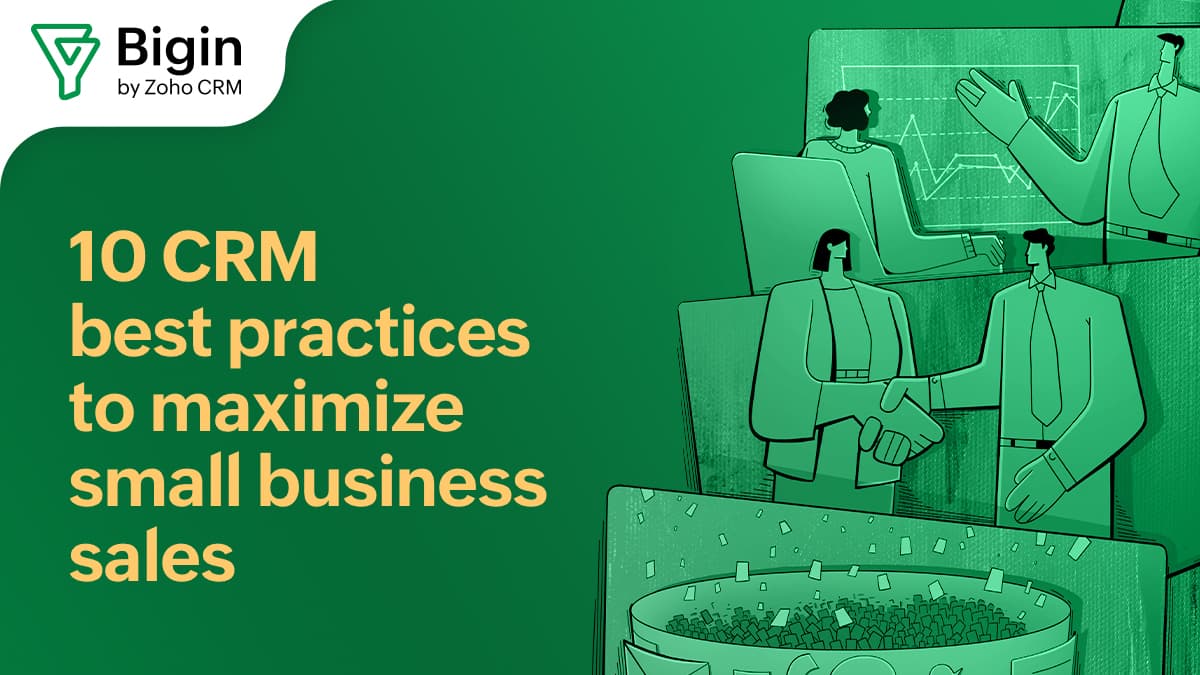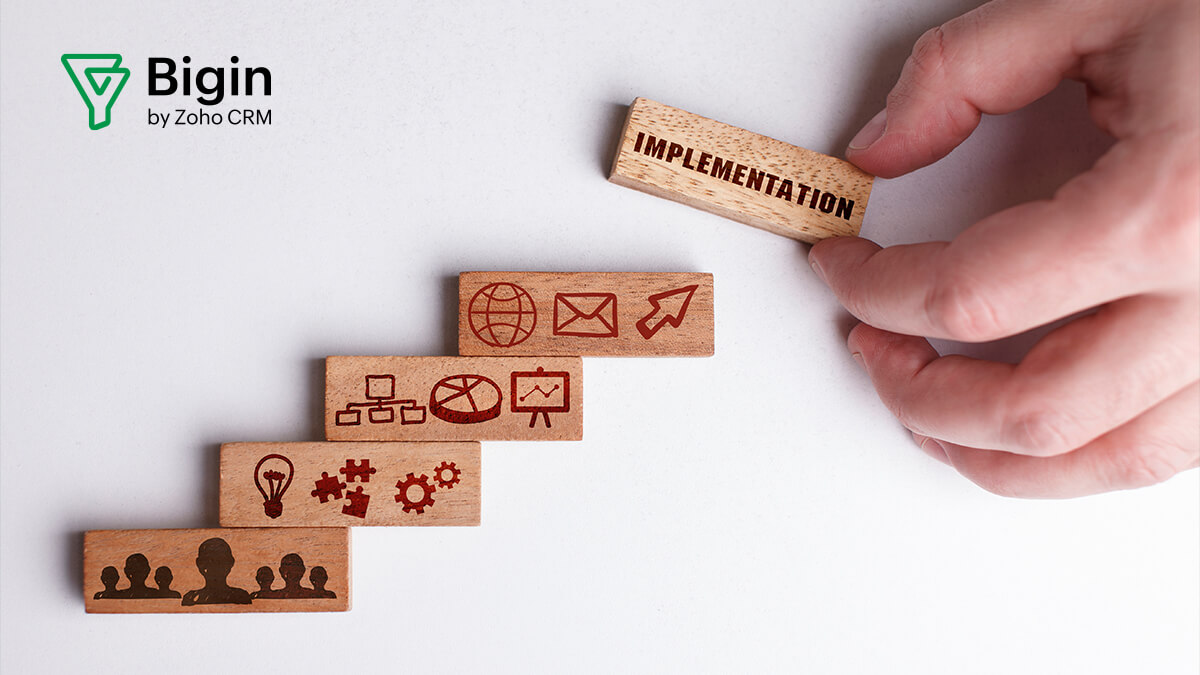10 CRM best practices to maximize small business sales in 2025
- Published : October 16, 2024
- Last Updated : October 16, 2024
- 707 Views
- 14 Min Read

Running a small business is so easy—said no one ever. Between managing operations, marketing, and customer service, it can feel like you're being pulled in a dozen different directions at once. When it comes to tracking customer interactions and nurturing leads, things can get even more complicated. That's where customer relationship management (CRM) tools come in.
CRMs have come a long way from their humble beginnings as simple contact management tools. Today's CRMs are more powerful and complex than ever. But here's the catch: Simply having a CRM isn't enough; to maximize your CRM investment and drive sales growth, you need to make sure you're using it strategically. From streamlining your sales process to building stronger customer relationships, it's not a stretch to suggest that the way you use your CRM can make or break your business.
That's why I’ve curated 10 CRM best practices to help you maximize sales in 2025. Whether you're new to CRMs or you've been using one, these tips will guide you in streamlining processes, strengthening customer relationships, and driving real results. Remember to contextualize these guidelines for your own business. I've framed these best practices to resonate with as many business owners as possible. Once you're done reading this piece, I recommend you do further research to learn how to optimize your CRM even more, keeping in mind the industry you're in. So, without further ado, let's dive in!
Tl;dr
Here are the 10 CRM best practices for maximising sales in 2025
1. Clean and accurate data
Maintain up-to-date, error-free data to avoid missed opportunities and flawed decision-making.
2. Automate repetitive tasks
Use CRM automation to handle follow-ups, task reminders, and lead nurturing, saving time and reducing human error.
3. Segment your customers for personalized outreach
Tailor communications based on customer behavior or demographics for more effective engagement.
4. Use data analytics to make smarter decisions
Leverage CRM analytics to track performance, understand customer behavior, and forecast trends.
5. Track and measure sales activities
Monitor sales processes and team performance to optimize strategies and increase accountability.
6. Integrate your CRM with other tools
Connect CRM with email, accounting, or ecommerce platforms to streamline workflows and data management.
7. Focus on customer retention, not just acquisition
Use your CRM to build loyalty with existing customers through personalized follow-ups and offers.
8. Implement a mobile CRM for on-the-go sales teams
Equip your sales team with mobile access to CRM data for real-time updates and interactions.
9. Leverage CRM for customer feedback and continuous improvement
Collect and analyze feedback through your CRM to improve products, services, and customer experiences.
10. Train your team continuously
Provide ongoing CRM training to ensure your team uses the system effectively and stays updated on new features.
1. Clean and accurate data
Imagine trying to build a house with faulty measurements. No matter how strong your foundation is, if your materials don't fit, you're set up for failure. The same logic applies to your CRM. Clean, accurate data is the backbone of any CRM system, and if the data in your system is incorrect, outdated, or full of duplicates, your entire sales process can collapse. You may be alarmed to learn that poor data quality costs organizations at least $12.9 million a year on average, according to a Gartner study from 2020. That raised my eyebrows for sure!
Why data accuracy is essential
For small businesses, having accurate customer data is super important because you have fewer resources to work with compared to larger enterprises. Incorrect phone numbers, outdated emails, or even misspelled names can lead to missed sales opportunities, damaged relationships, and wasted marketing efforts. There's so much at stake.
But the good news is that while maintaining clean data is definitely a best practice, it doesn't have to be a chore. Reviewing and updating your CRM regularly to ensure your team is working with reliable information will also help you segment your audience more effectively and personalize your outreach—an important aspect of sales these days.
 (Image via Syncmatters)
(Image via Syncmatters)
Moreover, accurate data plays a significant role in making data-driven decisions. Whether you're analyzing customer behavior or tracking sales performance, clean data enables you to spot trends, optimize processes, and stay ahead of the competition. If your data is full of errors, your analysis is going to be flawed, and that will lead to ineffective decision-making. It's a recipe for disaster
How to maintain clean data
Make it a habit to clean your CRM data regularly such that it becomes second nature to you and your team. Many CRMs have built-in features that help with data hygiene by flagging duplicate entries, suggesting corrections, or automatically updating customer information. Encourage your team to input data accurately and in real time to avoid mistakes.
Implementation tip: Dedicate time every quarter to cleaning your CRM data. Focus on removing duplicates, updating customer information, and archiving inactive leads. You can also create a checklist your team can follow when entering new customer details to ensure that they follow consistent data entry practices from the start. It might take some time to implement this, but once the wheels are in motion, it'll become a regular practice, and your sales function will be better off as a result.
2. Automate repetitive tasks
You didn't start your business to send the same email 50 times a day. You're leaving money on the table if you aren't automating manual tasks. According to a recent study, 74% of sales professionals who use AI think automation tools and features will make a significant impact on how they do their jobs in 2025. CRM automation frees your team from mundane, repetitive tasks, such as scheduling follow-up emails, assigning leads, and updating records, enabling them to focus on activities that move the needle—like closing deals.
How automation boosts productivity
Automation is particularly important for small businesses because it saves time and reduces human error. For example, you can set up an automated workflow that sends a welcome email the minute a lead submits their information through your website. You can even create complex workflows, such as a sequence of emails tailored to a lead's actions (e.g., if they clicked on a pricing page or downloaded a whitepaper).

(Image via Zoho Creator)
This isn't just about saving time—it's about ensuring consistency and professionalism in your customer interactions. Small businesses often have limited staff, so the more you can automate, the more you can focus on building relationships and driving sales.
Implementation tip: Start small. Use automation for follow-ups, task reminders, and lead nurturing workflows. Many CRMs offer templates that make it easy to set up these processes in just a few clicks. Remember to review your workflows periodically to ensure they're still relevant and effective.
3. Segment your customers for personalized outreach
Look, not all customers are created equal. Some are repeat buyers, others are price-sensitive, and some may just be curious browsers. A one-size-fits-all approach won't work, and that's where customer segmentation comes into play. In fact, according to a report by McKinsey and Company, 71% of buyers want companies to deliver personalized customer interactions.
By segmenting your customers based on their behaviors, demographics, or purchase history, you can tailor your outreach to meet their specific needs. This kind of personalized communication helps build trust and loyalty and leads to more conversions and long-term customer relationships.
 (Via Bernardo Medrado on Linkedin)
(Via Bernardo Medrado on Linkedin)
Why segmentation works
Let's try and understand with an example. Imagine you're running a fitness gear store, and you know that sending a mass email about discounts on yoga mats to customers who only bought weightlifting gear will likely lead to unsubscribes. If you send tailored offers based on each customer's purchase history, though, you're much more likely to see engagement and sales.
In fact, HubSpot reports that segmented campaigns can result in up to 760% higher revenue than non-segmented campaigns. Why? Because personalized messages resonate more. Small businesses can't afford to waste marketing efforts on irrelevant campaigns. With segmentation, you're sending the right message to the right person at the right time. In short, personalization gets you more bang for your buck.
Implementation tip: Use your CRM's segmentation tools to categorize your customers. Basic categories might include new customers, repeat buyers, or those who haven't made a purchase in six months. You can get more advanced by creating segments based on behavior, such as customers who've opened your last three emails or those who've visited your site but haven't made a purchase. Get creative and look for ways to segment that may benefit your business.
4. Use data analytics to make smarter decisions
Data is invaluable, and it's difficult to overstate how much it can help transform your business. CRMs are packed with data, but it's up to you to tap into it effectively. Data analytics features in modern CRMs help small business owners understand customer behaviors, track sales performance, and forecast trends. Instead of making decisions based on your gut feeling, you can now rely on hard data to guide your strategy. That's not to say that your intuitions have no role to play, but you stand to gain more by supplementing and calibrating your intuitions with facts.
The power of data-driven decisions
Let's say your CRM shows that customers who download your free whitepaper are 28% more likely to make a purchase than a lead who merely browses the blog section of your website. That's a golden insight. Now you can double-down on promoting that guide and optimize your sales funnel to convert those leads more effectively.
CRMs also help you identify your top-performing sales reps, campaigns, and products. If a particular sales strategy is working, you can replicate it. If a product isn't selling as expected, you can change your approach or perhaps focus on promoting higher-performing items.
 (Example of a dashboard in Bigin)
(Example of a dashboard in Bigin)
Data-driven decision-making can also help you spot trends early. If sales in a particular product category are dropping, you can adjust your inventory or marketing strategies before it impacts your bottom line.
Implementation tip: Review your CRM's analytics dashboard regularly. Set up custom reports to track metrics like conversion rates, customer acquisition costs, and customer lifetime value (LTV). These insights will give you a better understanding of where to focus your efforts to maximize sales with your CRM.
5. Track and measure sales activities
If you're not tracking and measuring every step of your sales process, it's challenging to identify what's working and what needs improvement. CRM software helps you monitor these activities and provides clear insights into the effectiveness of your strategy. This is particularly important for small businesses, for whom optimizing resources and maximizing efficiency is crucial.
By tracking sales activities, you can identify areas where leads are getting stuck in the funnel, assess the performance of individual team members, and ensure that follow-ups are happening as planned. It enables you to make data-driven decisions to refine your process and improve overall sales performance.
Why tracking matters
Sales tracking helps you identify bottlenecks in your process. For instance, if your leads are consistently stalling at the same stage, then maybe your team needs to tweak their follow-up approach. Are certain reps closing more deals than others? Maybe they have strategies that the rest of the team can learn from.
Tracking also ensures accountability. If your sales reps log their activities in your CRM, you have a clear record of what's been done and what's pending, which is a great way to maintain visibility and ensure that leads are being nurtured appropriately.
Additionally, by tracking how long it takes to move leads through the sales funnel, you can forecast more accurately and set realistic goals. This is handy when planning for growth and new targets.
Implementation tip: Use your CRM's sales pipeline feature to track each lead's journey from prospect to customer. Ensure that every sales activity—from calls to emails to meetings—is logged and visible. Set reminders for follow-ups and regular check-ins to keep the momentum going.
6. Integrate your CRM with other tools
Running a small business often means juggling multiple tools—email marketing software, accounting systems, ecommerce platforms, and more. According to a study by DevSquad, the average number of SaaS applications companies use rose from 80 to 130 between 2020 and 2022. Now, you may be thinking that that number must be much lower for small businesses—right? That's true, yes, but you're still probably using at least six or seven different software tools for different business functions. Rather than keeping these tools in different silos, integrating those tools into your CRM enables them to communicate with each other, which helps streamline your operations and gives you a more complete picture of your business.
How integrations improve efficiency
Let's look at an example: When you integrate your CRM with your email marketing tool, you can automatically sync customer contact details, see which email campaigns are driving engagement, and segment your email lists based on CRM data.

Similarly, if you integrate your CRM with your accounting software, you can track invoice status, payment histories, and outstanding balances in one place.
Integrations save time and reduce the errors that result from manual data entry. More importantly, they give you a unified view of each customer's journey with your business, from their first marketing touchpoint to their most recent purchase—and this helps you make more informed decisions.
Implementation tip: Many popular CRMs offer marketplaces for integrations with common small business tools like Mailchimp, QuickBooks, and Shopify. Identify the tools you use most and integrate them with your CRM to create a seamless flow of data across your operations.
7. Focus on customer retention, not just acquisition
Most businesses—especially small ones—tend to focus on acquiring new customers. After all, new customers mean more sales, right? Sure, but there's a catch: acquiring a new customer can cost five times more than retaining an existing one [Outbound Engine]. That's why focusing on customer retention is essential to building a sustainable, profitable business. And this is where your CRM shines.
Why retention equals long-term success
Your CRM can help you keep track of your most loyal customers and their purchasing behaviors. Armed with this information, you can implement loyalty programs, send personalized thank-you messages, or offer exclusive discounts. It's far easier to sell to an existing customer than to convince a new one to buy from you. Plus, loyal customers tend to spend more and are more likely to refer your business to others. I recently did an in-depth article on strategies to reduce customer churn in small businesses. Please take a look if you want to learn tried and tested strategies to improve customer retention rates.
By setting up customer retention workflows in your CRM, you can automate post-purchase follow-ups, send reminders for reorders, or offer special perks to customers on their anniversaries with your brand. Imagine getting a "we miss you" email with a special discount after a long period of inactivity. Simple yet effective, if you ask me.
Businesses that build meaningful, long-term relationships with customers thrive—and your CRM is the main tool that makes this easier.
Implementation tip: Use your CRM's reporting features to identify customers who haven't made a purchase in a while. Create re-engagement campaigns specifically for these segments that offer them personalized discounts or ask for feedback on why they've stopped purchasing.
8. Implement a mobile CRM for on-the-go sales teams
Gone are the days when sales reps were tied to their desks. Today, your sales team is likely working on the go—attending networking events, meeting clients, or even working remotely. For salespeople like these, a mobile CRM is vital, as it enables them to access customer information, log activities, and update records wherever they are.
The mobile advantage for small businesses
A mobile CRM provides sales reps with real-time access to customer details, even if they're in the field. Imagine your rep is about to walk into a meeting with a prospect. With a mobile CRM, they can quickly pull up the client's previous interactions, recent purchases, or any notes from other team members. This ensures the conversation is relevant, timely, and personalized.
Additionally, mobile CRMs enable your team to log calls, update lead statuses, and even create follow-up tasks while they're on the move. No more waiting until they're back in the office to update records—everything is logged in real time, reducing the chances of errors and missed opportunities.
 (Example of a screen from Bigin's mobile CRM)
(Example of a screen from Bigin's mobile CRM)
Small businesses that adopt a mobile CRM can stay agile, respond faster to customer inquiries, and close deals quicker. Today, staying agile is the key to staying competitive, and a mobile CRM ensures your team has the flexibility they need.
Implementation tip: Make sure your CRM has a robust mobile app that allows for full functionality—whether it's updating records, logging meetings, or pulling reports. Encourage your sales team to use the mobile app during client meetings and follow-ups to ensure that everything is updated in real time.
9. Leverage CRM for customer feedback and continuous improvement
Your CRM isn't just a sales tool; it's also a powerful platform for gathering and analyzing customer feedback. By leveraging customer feedback through your CRM, you can discover valuable insights into how your products or services are performing and identify areas for improvement. This practice helps you stay customer-centric, which is crucial for driving loyalty and increasing sales.
Why customer feedback matters
For small businesses, understanding customer satisfaction is essential to maintaining long-term success. Your CRM can help you collect feedback at key touchpoints, such as after a purchase or customer service interaction. By doing this, you can get direct insight into what's working well and where your business needs to improve.
Using feedback to fine-tune your offerings ensures that you're always evolving with your customers' needs, which builds trust and increases the likelihood of repeat business. Moreover, happy customers often refer new customers—which helps you grow your customer base organically.
How to implement feedback loops in your CRM
Integrate feedback collection into your CRM system by using tools like surveys, review requests, or follow-up emails. Many CRM platforms enable you to automate this process, which makes it easy to gather responses without manual effort. Once feedback is collected, your CRM can help you categorize it, analyze trends, and make data-driven decisions about what to improve.
(Image via Zoho Survey)
Implementation tip: Set up automated post-sale surveys in your CRM to gather feedback from customers a certain amount of time after their purchases. Analyze this data monthly to identify trends and common areas for improvement. If certain issues come up frequently, take action to address them and close the feedback loop by informing your customers of the improvements you've made.
10. Train your team continuously
Your CRM is only as effective as the people using it. Even if you've invested in the best CRM in the market, it won't do much good if your team isn't fully equipped to use it to its full potential—which is why continuous training is essential.
The importance of CRM training
CRM platforms are constantly evolving, with new features and updates rolling out regularly. Without ongoing training, your team may not be aware of these new features or best practices, and in turn may under-utilize the system.
By investing in continuous training, you ensure that your team stays up to date on the latest features and understands how to use the CRM to improve sales and customer interactions. It also encourages consistency across your team, as everyone will be using the CRM in the same way.
Implementation tip: Schedule regular CRM training sessions for your team, whether it's a monthly workshop or a quarterly refresher. Encourage your team to share tips and tricks they've discovered. Some CRM providers also offer online courses or certifications; encourage your staff to take advantage of these resources.
Final thoughts
There's so much you can do even with a simple CRM, and it can feel overwhelming at times, but we hope these guidelines make your life easier. Resist the urge to put these best practices on the backburner merely because they appear daunting. Once you start incorporating them in your work routine, the results will come.
Keep in mind that a CRM is only as effective as the strategy behind it. By adopting these best practices and tailoring them to your specific business needs, you'll be well on your way to building stronger customer relationships, closing more deals, and scaling your business successfully.
So let your CRM do the heavy lifting—it's an underrated tool that's going to do wonders for your company's growth.
Running a business is tough enough. Let Bigin simplify your sales process. Start your free trial and see the difference!
Further reading
Ever wondered how long it takes to implement a CRM? Read our article from earlier this year to find out!
Check out our easy CRM for small businesses guide

Still using spreadsheets? Read this to find out why sales teams should migrate to a CRM.

 Anubhav
AnubhavAnubhav is a product marketer with an insatiable thirst for all things content marketing, technology, and SaaS. His expertise lies in crafting compelling narratives that resonate with audiences and drive business growth. With a deep-rooted interest in entrepreneurship, Anubhav closely follows the latest industry trends and innovations, constantly seeking new ways to elevate marketing strategies.



